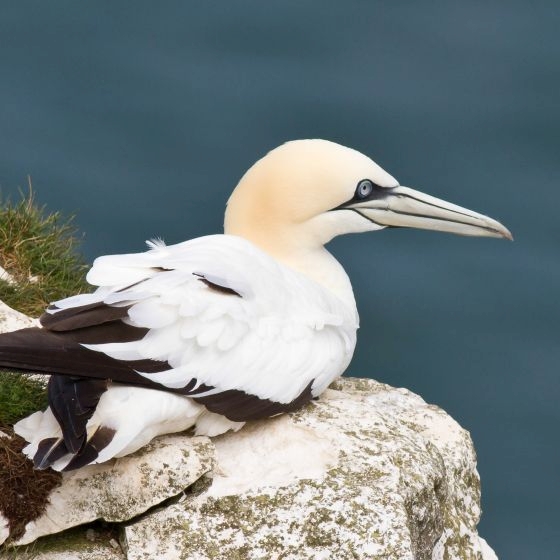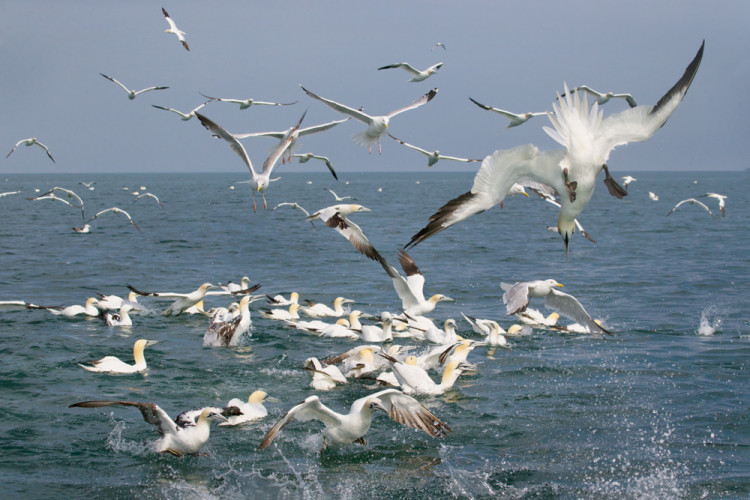Gannet
Morus bassanus (Linnaeus, 1758)
GX
 GANNE
GANNE  710
710

Family: Suliformes > Sulidae

With its two metre wingspan, warm yellow head, white body and black wingtips, this impressive bird will be familiar to most birdwatchers.
Even though the Gannet is restricted to a couple of dozen breeding colonies, individuals may be seen anywhere around our coast throughout the year. The breeding colonies are noisy, pungent affairs, the birds packed together with each individual just out of beak reach of its neighbours.
After the breeding season, most of our Gannets move to winter in the Bay of Biscay or further south to the coasts of west Africa, with some individuals crossing the Equator.
Identification
Gannet identification is usually straightforward.
SONGS AND CALLS
Listen to example recordings of the main vocalisations of Gannet, provided by xeno-canto contributors.
Call
Develop your bird ID skills with our training courses
Our interactive online courses are a great way to develop your bird identification skills, whether you're new to the hobby or a competent birder looking to hone your abilities.
Browse training coursesStatus and Trends
Population size and trends and patterns of distribution based on BTO surveys and atlases with data collected by BTO volunteers.
CONSERVATION STATUS
This species can be found on the following statutory and conservation listings and schedules.
POPULATION CHANGE
Much of the world population of this species breeds in the UK or Republic of Ireland,with most colonies located on offshore islands. Gannet colonies have been censused regularly with the last Census in 2013–15 and have increased consistently since 1969–70 by around 2% per annum (JNCC 2022).
DISTRIBUTION
The Gannet breeding distribution map shows that birds were recorded from virtually every coastal 10-km square in Britain and Ireland, representing a combination of adult birds ranging widely on foraging trips from colonies, non-breeding adults and immature birds. Confirmed breeding was confined to 32 10-km squares. In winter, Gannets were widely recorded around the entire coastlines of Britain and Ireland, with highest concentrations around the Northern Isles, off southeast Scotland, northwest and southwest England, and southwest Ireland.
Occupied 10-km squares in UK
| No. occupied in breeding season | 27 |
| % occupied in breeding season | 0.9 |
| No. occupied in winter | 506 |
| % occupied in winter | 17 |
European Distribution Map
DISTRIBUTION CHANGE
Change in occupied 10-km squares in the UK
| % change in range in breeding season (1968–72 to 2008–11) | +60% |
| % change in range in winter (1981–84 to 2007–11) | +47.1% |
SEASONALITY
Gannets can be seen year-round, though more often recorded in the breeding season and in early autumn.

Movement
Information about movement and migration based on online bird portals (e.g. BirdTrack), Ringing schemes and tracking studies.
RINGING RECOVERIES
View a summary of recoveries in the Online Ringing Report.
Foreign locations of birds ringed or recovered in Britain & Ireland

Biology
Lifecycle and body size information about Gannet, including statistics on nesting, eggs and lifespan based on BTO ringing and nest recording data.
SURVIVAL & LONGEVITY
View number ringed each year in the Online Ringing Report
Maximum Age from Ringing 
|
37 years 4 months 16 days (set in 1998) 
|
Typical Lifespan 
|
17 years with breeding typically at 5 year |
Adult Survival 
|
0.919±0.002  
|
Juvenile Survival 
|
0.3 (to age 4) 
|
CODES & CLASSIFICATION
Ring size 
|
K |
Field Codes 
|
2-letter: GX | 5-letter code: GANNE | Euring: 710 |
For information in another language (where available) click on a linked name
Research
Interpretation and scientific publications about Gannet from BTO scientists.
CAUSES AND SOLUTIONS
Causes of change
There are no clear reasons for the substantial increases in Gannet numbers. Like other seabird species, fisheries discards may have played a role in the second half of the twentieth century. Gannets have high survival rates, can fly long distances to forage and are adaptable and these factors may also have helped drive increases (JNCC 2022), which have continued (at least so far) in spite of reductions in fisheries discards which are affecting other species (Bicknell et al. 2013). However, a north American study has found that increasing sea surface temperatures (due to climate change) and over-exploitation by fisheries may be affecting productivity and causing declines at the southernmost colonies in Canada (d'Entremont et al. 2022). Hence, it is possible that similar issues could affect UK colonies in the future.
PUBLICATIONS (5)

Mismatches in scale between highly mobile marine megafauna and marine protected areas
Are marine protected areas working?
Predicting the impacts of wind farms on seabirds: An individual-based model
1.
Predictive modelling to identify near-shore, fine-scale seabird distributions during the breeding season
Survival of Gannets Morus bassanus in Britain and Ireland, 1959-2002
Use of gannets to monitor prey availability in the NE Atlantic Ocean: colony size, diet and foraging behaviour
Links to more studies from ConservationEvidence.com
Would you like to search for another species?











Share this page